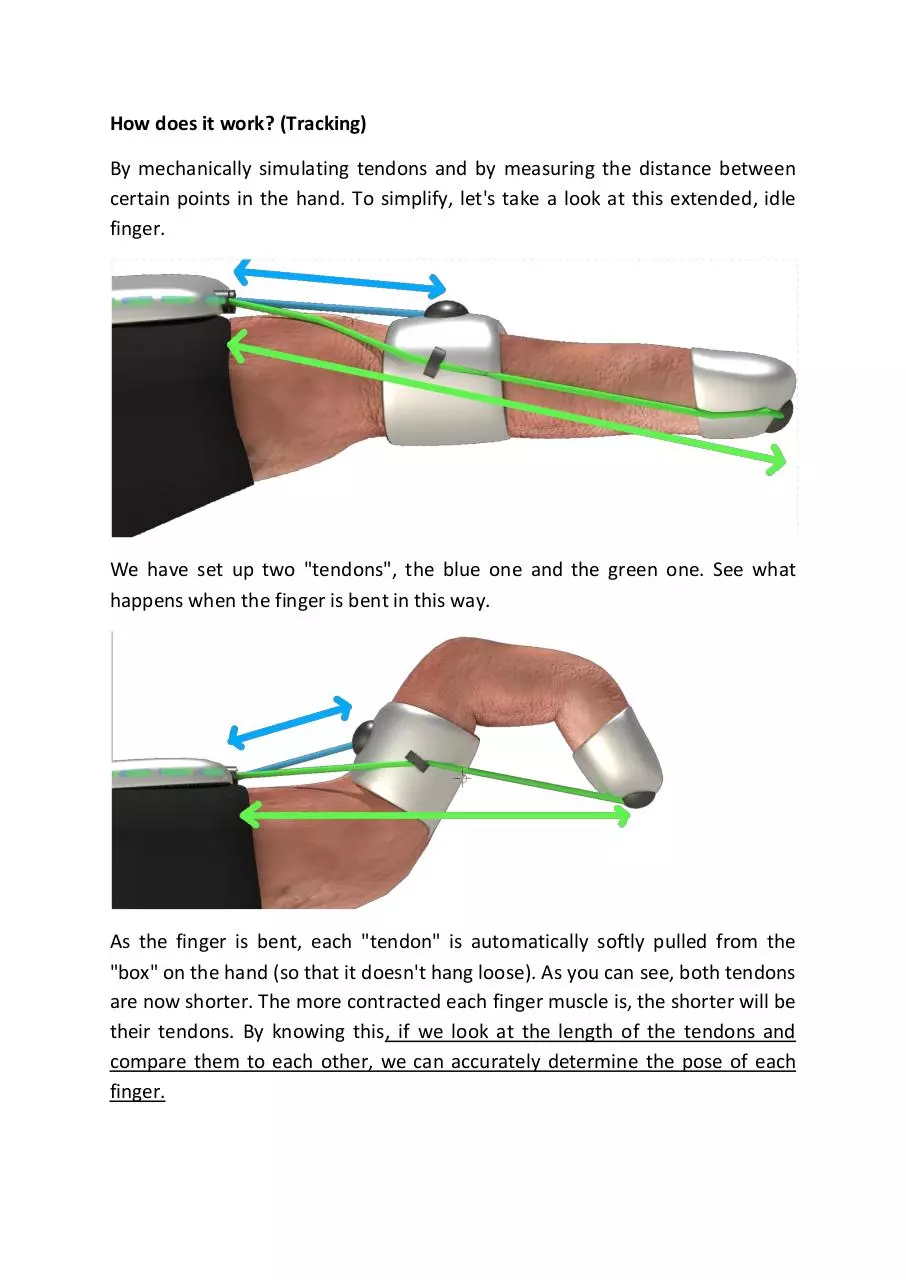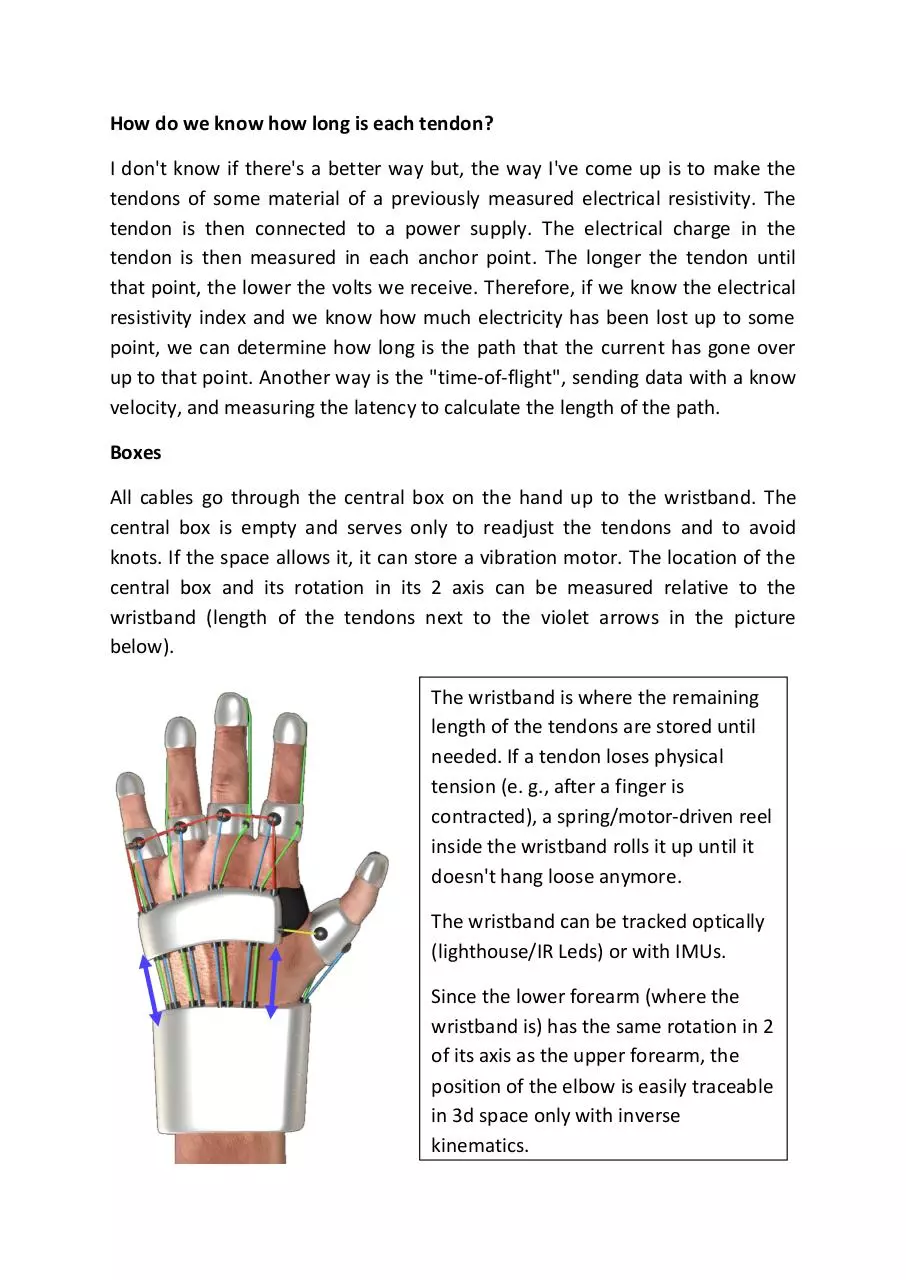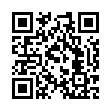DactulusVR The Puppeteer (PDF)
File information
Author: Daniel
This PDF 1.5 document has been generated by Microsoft® Office Word 2007, and has been sent on pdf-archive.com on 08/06/2015 at 13:51, from IP address 79.159.x.x.
The current document download page has been viewed 415 times.
File size: 1.02 MB (7 pages).
Privacy: public file





File preview
Aims
• Low-cost /HQ finger tracking
• No occlusion, 6DOF 360 freedom
• "Real" (pull) force feedback and finger blocking
-2 Haptic feedback outputs per finger
• Compatible with any kind of gamepad/wheel/joystick
• Computationally cheap → low latency
•Hand vibration
Prototype Concept (Unsexy but functional version)
How does it work? (Tracking)
By mechanically simulating tendons and by measuring the distance between
certain points in the hand. To simplify, let's take a look at this extended, idle
finger.
We have set up two "tendons", the blue one and the green one. See what
happens when the finger is bent in this way.
As the finger is bent, each "tendon" is automatically softly pulled from the
"box" on the hand (so that it doesn't hang loose). As you can see, both tendons
are now shorter. The more contracted each finger muscle is, the shorter will be
their tendons. By knowing this, if we look at the length of the tendons and
compare them to each other, we can accurately determine the pose of each
finger.
Short blue tendon and long
green tendon.
We can use this procedure with all
the fingers, thumb included.
Here's where we face the first problem. The first joint of each finger can rotate
in two axes. If we don't take that into account and measure only one axe,
finger movements in the other axe will lead us to wrong readings. That can be
fixed by adding a third tendon (the red/yellow ones in the picture below) and
making new measures.
How do we know how long is each tendon?
I don't know if there's a better way but, the way I've come up is to make the
tendons of some material of a previously measured electrical resistivity. The
tendon is then connected to a power supply. The electrical charge in the
tendon is then measured in each anchor point. The longer the tendon until
that point, the lower the volts we receive. Therefore, if we know the electrical
resistivity index and we know how much electricity has been lost up to some
point, we can determine how long is the path that the current has gone over
up to that point. Another way is the "time-of-flight", sending data with a know
velocity, and measuring the latency to calculate the length of the path.
Boxes
All cables go through the central box on the hand up to the wristband. The
central box is empty and serves only to readjust the tendons and to avoid
knots. If the space allows it, it can store a vibration motor. The location of the
central box and its rotation in its 2 axis can be measured relative to the
wristband (length of the tendons next to the violet arrows in the picture
below).
The wristband is where the remaining
length of the tendons are stored until
needed. If a tendon loses physical
tension (e. g., after a finger is
contracted), a spring/motor-driven reel
inside the wristband rolls it up until it
doesn't hang loose anymore.
The wristband can be tracked optically
(lighthouse/IR Leds) or with IMUs.
Since the lower forearm (where the
wristband is) has the same rotation in 2
of its axis as the upper forearm, the
position of the elbow is easily traceable
in 3d space only with inverse
kinematics.
Force feedback
Think of it as the dog of this picture. The motor, hidden in the wristband, pulls
the tendon when required. When the tendon is tensed, your finger will be
forced backwards, like the dog.
This is so for the blue tendons, the ones that are attached to the first segment
of your fingers. However, the case is the opposite with the green tendons.
As you can see, when tensed, the finger bents to the inner side of the hand.
This is useful. for example, when punching in-game. If you have your hands
closed, in the moment of the impact against the hitbox, the green tendons can
contract the tips of the fingers and pull them against the palm of the hands.
Other ingame situations where this could be useful are for example, when
pressing the tips of the finger against solid surfaces like, e.g., buttons or walls.
If the gameplay requires to tense the finger backwards, It would be enough to
tense only the blue tendon. It's a reflex reaction to extend the tips when the
basis of our fingers are pulled backwards.
That's all Folks!
Made by Daniel Arriaga.
(3D hand model used in the pictures made by DennisH2010
http://www.blendswap.com/blends/view/66039)
Download DactulusVR - The Puppeteer
DactulusVR - The Puppeteer.pdf (PDF, 1.02 MB)
Download PDF
Share this file on social networks
Link to this page
Permanent link
Use the permanent link to the download page to share your document on Facebook, Twitter, LinkedIn, or directly with a contact by e-Mail, Messenger, Whatsapp, Line..
Short link
Use the short link to share your document on Twitter or by text message (SMS)
HTML Code
Copy the following HTML code to share your document on a Website or Blog
QR Code to this page

This file has been shared publicly by a user of PDF Archive.
Document ID: 0000267677.